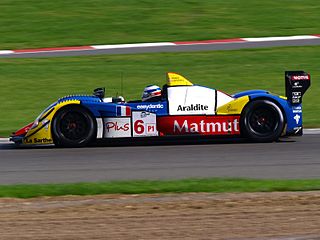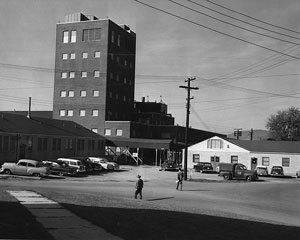ATC code C01Cardiac therapy is a therapeutic subgroup of the Anatomical Therapeutic Chemical Classification System, a system of alphanumeric codes developed by the World Health Organization (WHO) for the classification of drugs and other medical products. Subgroup C01 is part of the anatomical group C Cardiovascular system.
C1, C01, C.I or C-1 may refer to:
Novichok is a family of nerve agents, some of which are binary chemical weapons. The agents were developed at the GosNIIOKhT state chemical research institute by the Soviet Union and Russia between 1971 and 1993. Some Novichok agents are solids at standard temperature and pressure, while others are liquids. Dispersal of solid form agents is thought possible if in ultrafine powder state.

Courage Compétition was a racing team and chassis constructor company now owned by Oreca, based in Le Mans, France, near the Circuit de la Sarthe. It was founded by Yves Courage, a French race driver who ran hillclimbs before founding the company. Following the purchase of Courage by Oreca in 2007, Yves Courage has refounded the company as Courage Technology in 2010, attempting to develop electric racing cars.

Building 470 — also called the Pilot Plant, or sometimes “the Tower”, or “Anthrax Tower” — was a seven-story steel and brick building at Fort Detrick in Frederick, Maryland, United States, used in the small-scale production of biological warfare (BW) agents. The building, a Cold War era structure, was transferred from the Department of Defense to the National Cancer Institute-Frederick in 1988, to which it belonged until 2003 when it was demolished.
Southern Cross Airport is a public-use airport located 3 nmi (5.6 km) southwest of the central business district of the Williamstown section of Monroe Township, Gloucester County, New Jersey, United States. It is privately owned.
Garoga Site is an archaeological site located at Ephratah in Fulton County, New York. It is also known as Las-7, New York State Office of Parks, Recreation, and Historic Preservation Unique Site No. A035-04-0001. It is one of three Mohawk Indian village sites excavated by archaeologist Robert E. Funk in 1969–1970.
Klock Site is an archaeological site located at Ephratah in Fulton County, New York. It is also known as Las. 8-4, New York State Office of Parks, Recreation, and Historic Preservation Unique Site No. A035-04-0005. It is one of three Mohawk Indian village sites excavated by archaeologist Robert E. Funk in 1969-1970.
J. J. McKelvey is a former American football wide receiver. He was signed by the Tampa Bay Buccaneers as an undrafted free agent in 2003. He played college football at Clemson.
The Cougar C01, and its derivative, the Cougar C01B, were Group C sports car prototype race cars, designed, developed, and built by French constructor Cougar in 1984, and was used in sports car racing from 1982 to 1984. Its best result in the World Sportscar Championship sports car racing series was a tenth-place finish 1983 1000 km of Mugello, being driven by Yves Courage, Aldo Bertuzzi, and Gianni Giudici.

A-232 is an organophosphate nerve agent. It was developed in the Soviet Union under the FOLIANT program and is one of the group of compounds referred to as Novichok agents that were revealed by Vil Mirzayanov. A-232 is reportedly slightly less potent as a nerve agent compared to some of the other compounds in the series such as A-230 and A-234, having similar potency to the older nerve agent VR. However it proved to be the most versatile agent as it was chemically stable and remained a volatile liquid over a wide temperature range, making it able to be used in standard chemical munitions without requiring special delivery mechanisms to be developed.

A-234 is an organophosphate nerve agent. It was developed in the Soviet Union under the FOLIANT program and is one of the group of compounds referred to as Novichok agents that were revealed by Vil Mirzayanov. In March 2018 the Russian ambassador to the UK, Alexander Yakovenko, claimed to have been informed by British authorities that A-234 had been identified as the agent used in the poisoning of Sergei and Yulia Skripal. Vladimir Uglev, one of the inventors of the Novichok series of compounds, said he was "99 percent sure that it was A-234" in relation to the 2018 Amesbury poisonings, noting its unusually high persistence in the environment.
Forbidden Island is a 1999 American TV series.

C01-A039 is a Novichok agent. It is the ethyl phosphorofluoridate ester of phosgene oxime.

C01-A042 is a Novichok agent.

A-230 is an organophosphate nerve agent. It was developed in the Soviet Union under the FOLIANT program and is one of the group of compounds referred to as Novichok agents that were revealed by Vil Mirzayanov. A-230 is possibly the most potent nerve agent for which specific toxicity figures have been published, with a human lethal dose estimated to be less than 0.1 mg. However it was felt to be less suitable for weaponisation than other agents such as A-232 and A-234, due to issues with the liquid agent exhibiting low volatility and solidifying at low temperatures, as well as poor stability in the presence of water.

A-242 is an organophosphate nerve agent. It was developed in the Soviet Union under the FOLIANT program and is one of the group of compounds referred to as Novichok agents that were revealed by Vil Mirzayanov. Mirzayanov gives little specific information about A-242, stating that it is highly toxic but no figures are given to compare it to other related agents. It is reportedly a solid rather than a volatile liquid as with most nerve agents, and in order to weaponise it successfully, it had to be milled into a fine powder form that could be dispersed as a dust.

A-262 is an organophosphate nerve agent. It was developed in the Soviet Union under the FOLIANT program and is one of the group of compounds referred to as Novichok agents that were revealed by Vil Mirzayanov. Mirzayanov gives little specific information about A-262, stating that it is highly toxic, but no figures are given to compare it to other related agents. It is reportedly a solid rather than a volatile liquid as with most nerve agents, and in order to weaponise it successfully, it had to be milled into a fine powder form that could be dispersed as a dust.









